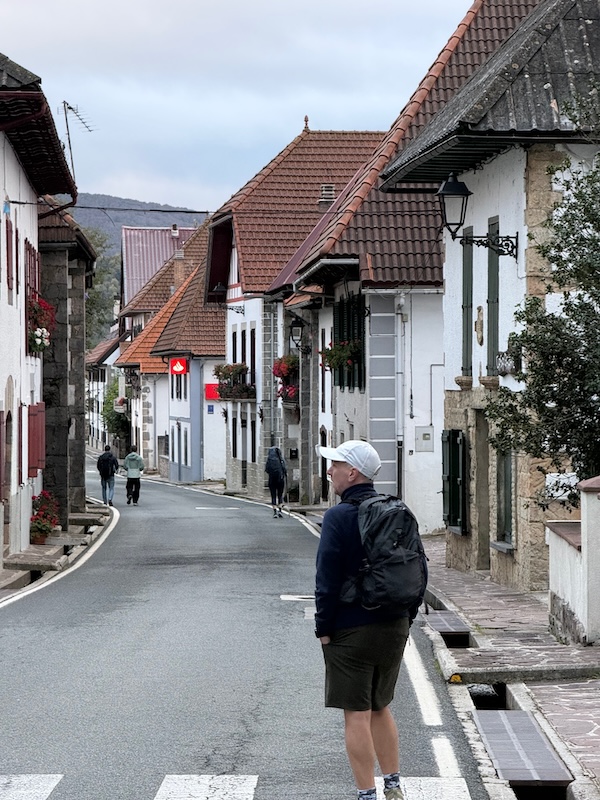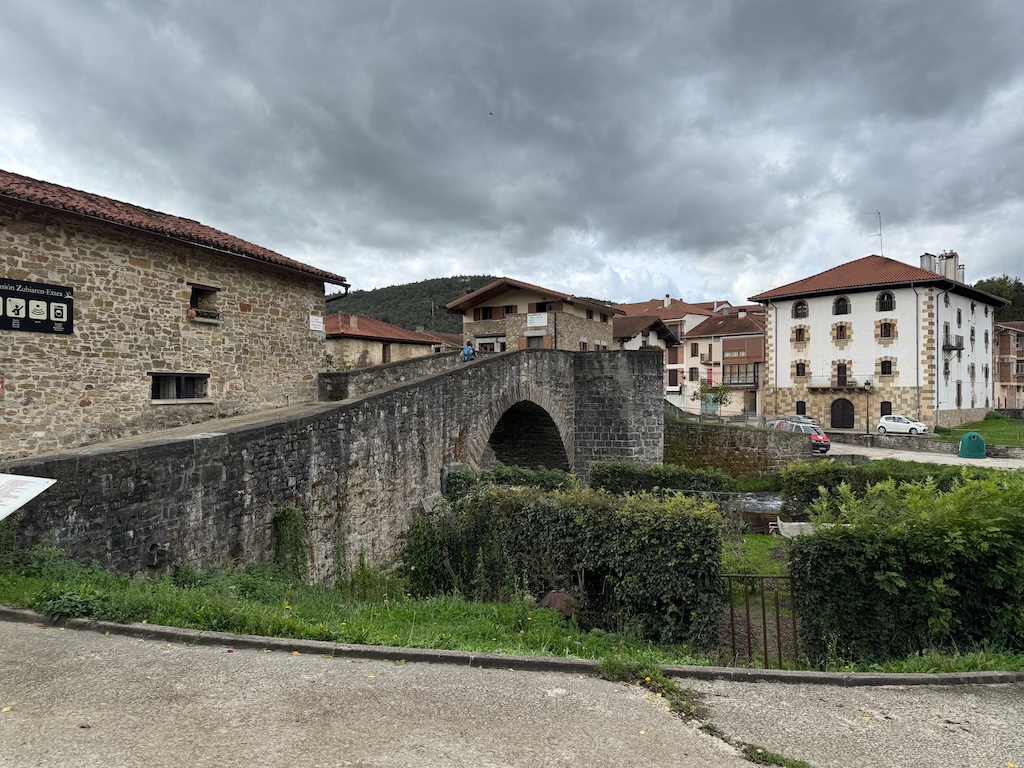
Continuing our pilgrimage, we left Roncesvalles around 8:00 am and started walking. I think I’ll leave the photos to do most of the heavy lifting for this day’s walk. Although the trajectory was mainly downhill, you can see from the elevation detail above that there were a few steep uphills. After the previous day’s effort my glutes were feeling it, and I had to keep stopping to try to stretch them out so that my hip joint swung smoothly. In the end, I gritted my teeth and got it done. The countryside was dotted with little villages with the typical white, shuttered houses of this region and we had a mix of forest walking and farmland. Throughout this section of our walk, signs were often in Spanish and Basque. The Basque language intrigued me because it was nothing like other European languages with all its Ts and Xs. I would find out more later, but it remained a mystery for now.
We crossed paths a few times with “Bro and Sis”, who we’d met the previous day. They thought we were very hardy walking around in shorts, so I had to tell them our walking philosophy that we picked up on our Three Capes hike—Go bold, Go cold—because you soon warm up once you get walking steadily. I also need very little activity to break into a sweat, so I prefer to be a little bit cold at the start rather than having to stop all the time to take clothes off. We chatted and learned that Bro works for the same large multinational firm as my sister. I would have liked to walk a bit further with them, but when we chatted with them in Zubiri ,they said they would keep walking for another couple of hours, so we wished them luck and said our goodbyes.






At about 10:30, we came to Bizkarreta and stopped at Bar Dena Ona on the outskirts for some morning tea. I had fresh orange juice and a tortilla. It was really good. I love the fresh orange juice you can get in Europe, and I went on a bit of a mission at the start of our trip, trying all the tortillas I could. This one was warm and not too firm. The place felt authentic; there was a group of locals at one table when we got there, along with a few other pilgrims. It was a relief to pass through villages and towns where we could sit down out of the weather and use a proper toilet after the previous days almost non-stop hike.







Coming down into Zubiri, the path was pretty steep, rocky, and at times perilous. For most of the time, we were fine, but there was one section near the end where I paused to decide how I was going to tackle it. A Spanish man came up behind us and offered me one of his walking poles, which I happily accepted. It made navigating the steep, rocky section a lot easier. So, poles are probably helpful for anyone who is doing this section. Later, when we ran into the “Ladies from Shep” in town, I told the story, saying, “he gave me a walking stick.” K frowned and said, “Walking poles, not walking sticks”, and we all chuckled. It became a running joke for the rest of the trip—when I wanted to needle K, I’d mention her “walking sticks.”
At 5 pm, there was what was advertised as a prayer service at the church. Which it was. We also got a church tour, including up into the old bell tower. The service was led by a volunteer from Mexico, and translations were provided in various languages in a book, but our guide spoke some English, and one of the pilgrims was from Mexico and spoke good English and offered to translate for us. He also talked about the pilgrimage and his joy and evident excitement over the possibilities of pilgrimage, which was infectious. Several of us took turns reading the prayers or scriptures in English as we moved through the church. The original church was destroyed in the Carlist war, so this is a reconstruction, and the Altarpiece was transferred from a church in Pamplona. Going up in the bell tower, we had to walk up each stairway between levels two at a time to avoid putting too much weight on them. Our prayer service at Zubiri was a highlight for G and I.
Zubiri is a very small town with only a few food options. We thought the one place open for dinner was closed due to the language barrier and a bit of confusion over AM/PM. In the end, we grabbed a baguette from a little cafe before it closed, ate some of our fruit, and finished up with a couple of Magnums from the small grocery shop. Our accommodation was wonderful in a typical Navarran 17th-century mountain home, Casa Rural Txantxorena. There was a communal lounge, and our host did our laundry for a small fee. Breakfast the following day was excellent.




The stats from G’s Garmin: Distance – 21.66 km; Total Elevation Gain – 393 m; Moving Time: 5:01:37.
And off my Garmin: Steps – 37,426.
For mountains and rough paths, hiking poles can make the hiking much easier. If you’re a hiker, are you a keen walking pole user, or are you a bit like us and would prefer not to so we don’t have to carry them when we don’t need them?

Comments
4 responses to “Camino de Santiago: Roncesvalles to Zubiri”
Spanish tortillas is my husband’s specialty! He made one for my parents last weekend as they hadn’t had one before. He studied abroad in Spain so ate a lot of them. He puts ham in his and makes them more ‘firm’. I went to Spain in 2016 and ate a lot of them since it was a good gluten free option. Some of them were quite ‘yolky’ though. I prefer them firmer.
I prefer to hike without poles. I usually get by fine without them but there was one hike I did in NC where I had to borrow a pole from someone for a downhill section and was wishing I had some.
I like the yolky type, but I also like my scrambled eggs just underset and runny poached and fried. I wouldn’t say no to someone cooking it for me at home with ham in though!
I only ever had one Spanish tortilla I Mae myself which was fine. But I would love to try one in the country. I am getting confused with the term tortilla though as everyone is saying it and it always looks different.
Anyways, your walk looks lovely again. I am not much of a hike (anymore) but I would not use walking sticks. Poles… whatever. I sometimes ski without stick because it feels easier. But I haven’t skied in forever so many I need them now.
THe tortilla I’m thinking about is the potato and egg cooked in a pan, like a frittata.